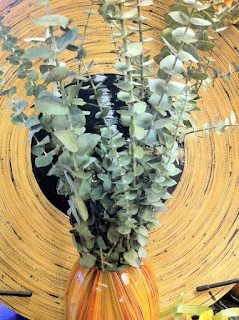As part of our 125th Anniversary celebration
at Stein Your Florist Co. we are sharing a year of floral education, November
1, 2012 thru October 31, 2013. Each day we will post something new on our Facebook page to share
our knowledge of our favorite things, flowers and plants and we'll be updating
our blog every 5 days or so. No need for pencils and notebooks, just sharing
some simple lessons in floristry.
 Day 131 - Years of careful training is required to
master the art of bonsai. Bonsai trees take years to form and train. In many
cases the tree’s growth is even deliberately stunted to achieve the desired
shape. They are extremely delicate; even the slightest amount of neglect can
ruin or even kill a bonsai. Older specimens are priceless, cherished as
heirlooms, museum pieces, and collector’s items. The oldest specimens
identified are believed to be at least 800 years old. It is impossible to
accurately date a tree without damaging it, so the age of most bonsai trees is
educated guesswork based on whatever records are available, the kind of tree,
and the style of clipping. What’s more, many of the most spectacular specimens
are in private Japanese collections and abroad, not accessible to the public.
The bonsai pictured here is approximately 75 years old.
Day 131 - Years of careful training is required to
master the art of bonsai. Bonsai trees take years to form and train. In many
cases the tree’s growth is even deliberately stunted to achieve the desired
shape. They are extremely delicate; even the slightest amount of neglect can
ruin or even kill a bonsai. Older specimens are priceless, cherished as
heirlooms, museum pieces, and collector’s items. The oldest specimens
identified are believed to be at least 800 years old. It is impossible to
accurately date a tree without damaging it, so the age of most bonsai trees is
educated guesswork based on whatever records are available, the kind of tree,
and the style of clipping. What’s more, many of the most spectacular specimens
are in private Japanese collections and abroad, not accessible to the public.
The bonsai pictured here is approximately 75 years old.
Day 132 - Daffodils
were taken out of the "wild" & planted in English gardens in the
early 1600s. Long known as the harbingers of Spring, this was the first use of
them as a garden flower. Like all bulbs, they must "winter" in order
to bloom; they need 3 months of cold in order to flower.
 Day 133 - Lilies
are stunning, but their pollen can be a mess. As lilies open, stamen begin to
pollenate, which can stain hands, clothing, or anything else that may brush
against it. To eliminate this possible problem, remove the stamen as the lily
begins to open by pulling the not-yet-pollenated stamens by hand, or, if you
prefer to leave stamen intact for a more natural look, you may spray plain
unscented, extra hold hairspray directly onto the stamen. This will inhibit
them from pollenating. This will not damage the lily petals so long as the
hairspray is unscented (the fragrance from the hairspray contains alcohol and
will burn or damage the lily petals). So control the pollen and enjoy your
lilies!
Day 133 - Lilies
are stunning, but their pollen can be a mess. As lilies open, stamen begin to
pollenate, which can stain hands, clothing, or anything else that may brush
against it. To eliminate this possible problem, remove the stamen as the lily
begins to open by pulling the not-yet-pollenated stamens by hand, or, if you
prefer to leave stamen intact for a more natural look, you may spray plain
unscented, extra hold hairspray directly onto the stamen. This will inhibit
them from pollenating. This will not damage the lily petals so long as the
hairspray is unscented (the fragrance from the hairspray contains alcohol and
will burn or damage the lily petals). So control the pollen and enjoy your
lilies!
Day 134 - Oxalis
plants, the largest genus of the wood sorrel family, are a popular St.
Patrick’s Day plant, also being known as a false shamrock. Most of these grow
from small bulbs although some have tuberous roots. The distinguishing
characteristic is the three rounded or triangular-shaped leaves at the end of
delicate stems. Most oxalis plants fold up their leaves at night, hugging them
tight to the stems until daylight "wakes them up" again. It is worthy
to note that any oxalic acid containing plant is poisonous to humans in some
dosage, so don’t eat them!
 Day 135 - The
anemone is one of the earliest flowers in spring, appearing in late
March/April, and continuing through May. They are a great cut flowers and will
give you around 9 days of vase life when properly cared for. Recut the stems at
an angle, removing one to two inches with a sharp knife to allow for better
water intake. Use a clean vase and fresh water, keep them in medium light and
in a cool spot to prolong vase life. This flower prefers the cold water and the
cold spaces. Anemones will open in light and heat so be sure to keep plan
appropriately for blooming purposes. Refresh the water daily; they are heavy
drinkers so check their water level frequently when hydrating and arranging.
Adding nutrients to the water (cut flower "food”) will also help to extend
the freshness of anemone arrangements. Finally, anemones continue to grow after
arranging, so leave enough room in bouquets for flowers to open.
Day 135 - The
anemone is one of the earliest flowers in spring, appearing in late
March/April, and continuing through May. They are a great cut flowers and will
give you around 9 days of vase life when properly cared for. Recut the stems at
an angle, removing one to two inches with a sharp knife to allow for better
water intake. Use a clean vase and fresh water, keep them in medium light and
in a cool spot to prolong vase life. This flower prefers the cold water and the
cold spaces. Anemones will open in light and heat so be sure to keep plan
appropriately for blooming purposes. Refresh the water daily; they are heavy
drinkers so check their water level frequently when hydrating and arranging.
Adding nutrients to the water (cut flower "food”) will also help to extend
the freshness of anemone arrangements. Finally, anemones continue to grow after
arranging, so leave enough room in bouquets for flowers to open.




























